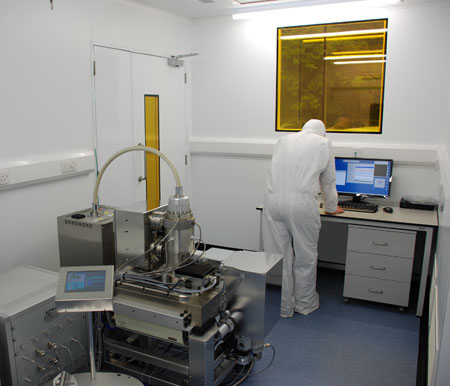The UK-based University of Exeter has built a new facility to research a promising material known as Graphene that is just one atom thick. Jan Pyrgies, Cleanroom Solutions, describes the build.
The University of Exeter has established the Centre for Graphene Science in a joint venture with the University of Bath. Graphene is a conductive sheet of carbon just one atom thick and is the building block of crystal graphite. It has been described as one of the most promising and versatile materials ever discovered. It has a unique combination of optical, electrical and mechanical properties suitable for many applications, including microchips and touch screen technology.
The £500,000 complex at the School of Physics in Exeter was designed and built by Cleanroom Solutions to meet the university’s stringent criteria. The facility included a number of ISO class 5 and class 6 rooms with class 5 chemical process benches (wet benches) as well as a fully equipped changing room.
Clean air was supplied using fan/filter modules with fresh air coming from the air conditioning equipment located on the building’s roof. A specially designed steel frame supports the air conditioning equipment with support stubs penetrating through the roof onto structural walls.
Due to the close temperature control required (+/-0.2°C), a chiller was chosen to provide cooling and its control system was incorporated into the University’s BMS system.
Wet benches were custom designed to provide processing areas for acid and solvent based processes. The benches were fitted out to the university’s specific requirements and incorporate safety features, such as eye washes and extract alarms.
A range of piped gas services were incorporated into the design, mainly from bottle stored gases. The compressed air was provided by a dedicated compressor and dryer. The compressor also fed a nitrogen generator to eliminate the need for bottled nitrogen. The rooms were fitted out with cleanroom benching, cupboard units, small power and three-phase power in all work areas.
The University of Exeter has an energy-saving policy and requested that the facility include energy-saving design solutions. To adhere to the brief, Cleanroom Solutions looked at minimising the environmental impact of the project, while also meeting the running constraints.
The scheme included:
- A dry air cooler for “free cooling”, which operates when ambient temperatures are below the return water temperature of the sensible cooling coils. This arrangement considerably reduces the operation of the compressors in the air-cooled chiller and thereby saves energy and running costs. The main chiller will need to operate only when ambient temperatures exceed 12°C.
- The wet benches represent a large energy running cost (expensive conditioned air is extracted to atmosphere). A cost-saving scheme was incorporated such that, if a bench is not operating the extract air can be significantly turned down. The treated fresh air is turned down accordingly, thus saving on running costs. A reduced extract is maintained for safety reasons. Room pressures are maintained at the same level.
Lighting is high efficiency with T5 tubes and is operated by passive infra red (PIR) control.
The Graphene Centre cleanroom is a purpose-built semiconductor-type facility with advanced HVAC control of temperature and humidity throughout the working areas. The air conditioning control system has a set-back facility so that the tight temperature and humidity constraints are relaxed when the room is not being used (i.e. weekends and at night).
The cleanroom complex has also been fitted out with an existing optical lithography system and ancillary equipment – optical microscopes, wire bonding tool, room temperature wafer probe station, surface profiler, split tube annealing furnace and a dicing saw – are incorporated to make this, as much as possible, a self-contained installation.

The Electron Beam Lithography cleanroom that allows the centre to fabricate a wide range of nanoscale devices
Significant equipment purchases for the facility include:
A NanoBeam Electron Beam Lithography System – a state-of-the-art dedicated electron beam lithography tool capable of producing 10nm lines (±15%) across a 250µm field using a 2nA focused electron beam. Each of the fields can be accurately positioned and joined (stitched) together using a 195mm x 195mm precision stage controlled by a 0.31nm (l/2048) laser interferometer system. It has a 20 bit, 55MHz pattern generator with 1nm resolution (beam-step) at a 1mm field size. The NanoBeam system is capable of directly writing on a variety of samples ranging from 5–150mm square, which allows the centre to fabricate optical mask plates in addition to doing direct write lithography on small samples. It has a 10-chuck automatic airlock that allows unattended operation overnight and at weekends.
An EBeam Evaporation System – a custom designed Combined Electron Beam and Sputtering Evaporation System with substrate RF DC biasing and the capacity to oxidise samples during the deposition process. It has a 10kW Ebeam power supply, which means it is capable of evaporating a wide range of materials. It also has a 3in diameter sputtering target for enhanced deposition uniformity and automatic operation using a recipe driven computer control system.
An RIE Etching System – a computer controlled Reactive Ion Etching system that is fitted with a Laser Etch Penetration Depth (EPD) monitoring system to control the etch process accurately. It has the facility to use six different process gases so can readily be adapted for future research work.
David Anderson, cleanroom manager at the Centre for Graphene Science, said: “Cleanroom Solutions understood our requirements; they designed and built a first class facility with which we are very pleased. They demonstrated high levels of flexibility and commitment throughout the project, overcoming any challenges put before them.”

The coating, processing and validation cleanroom




